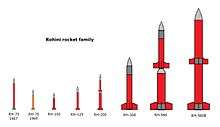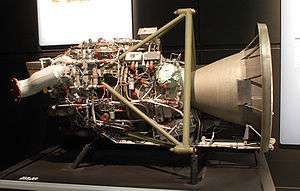Rohini (rocket family)
Rohini is a series of sounding rockets developed by the Indian Space Research Organisation (ISRO) for meteorological and atmospheric study. These sounding rockets are capable of carrying payloads of 2 to 200 kilograms (4.4 to 440.9 lb) between altitudes of 100 to 500 kilometres (62 to 311 mi).[1] The ISRO currently uses RH-200, RH-300, RH-300 Mk-II and RH-560 Mk-II rockets, which are launched from the Thumba Equatorial Rocket Launching Station (TERLS) in Thumba and the Satish Dhawan Space Center in Sriharikota.

Nomenclature
The rockets in the series are designated with the letters RH (for "Rohini"), followed by a number corresponding to the diameter (in millimetres) of the rocket.[2]
Series
- RH-75
The RH-75, the first sounding rocket developed by India,[3] was launched from TERLS on November 20, 1967.[4] It weighed 32 kilograms (71 lb), had a diameter of 75 millimetres (3.0 in) and flew 15 times between November 1967 and September 1968.
- RH-125
This rocket was launched on October 9, 1971 from Sriharikota. It was a two-stage rocket using a solid propellant, carrying a 7 kilograms (15 lb) payload to 19 kilometres (12 mi) in altitude. It flew twice between January 1970 and October 1971.
- RH-200
The RH-200 has a maximum launch altitude of 70 kilometres (43 mi).[5]
- RH-300
The Rh-300 is a single stage sounding rocket, derived from French Belier rocket engine technology. It has a launch altitude of 100 km (90 mi). A variant, the RH-300 Mk-II, has a maximum launch altitude of 116 kilometres (72 mi).[5]
- RH-560
This two stage vehicle is derived from French Stromboli engine technology. Another variant, the RH-560 Mk-II, can reach a maximum launch altitude of 548 kilometres (341 mi).[5]
Applications
The RH-200 is used for meteorological studies, the RH-300 Mk-II for upper-atmospheric studies and the RH-560 Mk-II for ionospheric studies. The RH-200 was used as the rocket for the first payload launch in India made by students (from VIT University in Vellore). The team members include Dev Sharma, Sunayan Kumar, Himanshu Misra, Chandresh Mittal, Ankit Sharma, Manish Kumar Narnoli, Nitesh Kumar and Gautam Alok.[6]
| Name | RH 75 | RH 125 | RH 200/125 | RH-300 | RH-300 Mk II | RH-300/200/200 | RH-560/300 | RH-560/300 Mk II |
|---|---|---|---|---|---|---|---|---|
| Gross mass | 8 kg (18 lb) | 40 kg (88 lb) | 100 kg (220 lb) | 300 kg (660 lb) | 500 kg (1,100 lb) | 500 kg (1,100 lb) | 1,300 kg (2,800 lb) | 1,600 kg (3,530 lb) |
| Height | 1.50 m (4.90 ft) | 2.50 m (8.20 ft) | 3.60 m (11.80 ft) | 4.10 m (13.40 ft) | 5.90 m (19.30 ft) | 8.00 m (26.20 ft) | 8.40 m (27.50 ft) | 9.10 m (29.80 ft) |
| Diameter | 0.0800 m (0.2620 ft) | 0.12 m (0.39 ft) | 0.20 m (0.65 ft) | 0.31 m (1.01 ft) | 0.31 m (1.01 ft) | 0.31 m (1.01 ft) | 0.56 m (1.83 ft) | 0.56 m (1.83 ft) |
| Thrust | 8.00 kN (1,798 lbf) | 17.00 kN (3,821 lbf) | 38.00 kN (8,542 lbf) | 39.00 kN (8,767 lbf) | 38.00 kN (8,542 lbf) | 76.00 kN (17,085 lbf) | 76.00 kN (17,085 lbf) | |
| Apogee | 10 kilometres (6.2 mi) | 20 kilometres (12 mi) | 80 kilometres (50 mi) | 100 kilometres (62 mi) | 150 kilometres (93 mi) | 300 kilometres (190 mi) | 400 kilometres (250 mi) | 500 kilometres (310 mi) |
| Stages | 1 | 1 | 2 | 1 | 1 | 3 | 2 | 2 |
| First Launch | 20 November 1967 | 1 January 1970 | 1 January 1979 | 8 June 1987 | 1 November 1985 | 24 April 1974 | 16 August 1995 | |
| Payload (kg) | 1 | 7 | 10 | 60 | 70 | 100 |
References
- ↑ Subramanium, T S (16 January 2004). "Reaching out to the stars". Frontline. Archived from the original on 19 February 2010. Retrieved 10 March 2012.
- ↑ "ISRO > FAQ". Frequently Asked Questions: ISRO. Indian Space Research Organisation.
- ↑ Chari, Sridhar K (22 July 2006). "Sky is not the limit". The Tribune. Retrieved 10 March 2012.
- ↑ http://www.isro.org/scripts/faq.aspx
- 1 2 3 Venugopal, P (15 January 2010). "Ten rockets fired to study solar eclipse". The Hindu. Retrieved 11 March 2012.
- ↑ "Isro launches rocket with part made by students". The Financial Express. 8 July 2010. Retrieved 25 July 2013.

